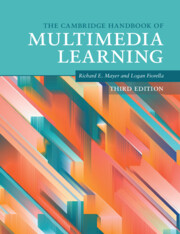Book contents
- The Cambridge Handbook of Multimedia Learning
- The Cambridge Handbook of Multimedia Learning
- Copyright page
- Contents
- Figures
- Tables
- Contributors
- Preface
- Acknowledgments
- Part I Background
- 1 Introduction to Multimedia Learning
- 2 Foundations of Multimedia Learning
- 3 Fifteen Common but Questionable Principles of Multimedia Learning
- 4 Research Methods in Multimedia Learning
- Part II Theoretical Foundations
- Part III Basic Principles of Multimedia Learning
- Part IV Principles for Reducing Extraneous Processing in Multimedia Learning
- Part V Principles for Managing Essential Processing in Multimedia Learning
- Part VI Principles Based on Social and Affective Features of Multimedia Learning
- Part VII Principles Based on Generative Activity in Multimedia Learning
- Part VIII Multimedia Learning with Media
- Author Index
- Subject Index
- References
1 - Introduction to Multimedia Learning
from Part I - Background
Published online by Cambridge University Press: 19 November 2021
- The Cambridge Handbook of Multimedia Learning
- The Cambridge Handbook of Multimedia Learning
- Copyright page
- Contents
- Figures
- Tables
- Contributors
- Preface
- Acknowledgments
- Part I Background
- 1 Introduction to Multimedia Learning
- 2 Foundations of Multimedia Learning
- 3 Fifteen Common but Questionable Principles of Multimedia Learning
- 4 Research Methods in Multimedia Learning
- Part II Theoretical Foundations
- Part III Basic Principles of Multimedia Learning
- Part IV Principles for Reducing Extraneous Processing in Multimedia Learning
- Part V Principles for Managing Essential Processing in Multimedia Learning
- Part VI Principles Based on Social and Affective Features of Multimedia Learning
- Part VII Principles Based on Generative Activity in Multimedia Learning
- Part VIII Multimedia Learning with Media
- Author Index
- Subject Index
- References
Summary
Multimedia learning is learning from words and pictures. The rationale for studying multimedia learning is that people can learn more deeply from words and pictures than from words alone. A goal of research on multimedia learning is to understand how to design multimedia learning environments that promote meaningful learning. The research base concerning multimedia learning is reflected in the 46 chapters of this Handbook, and includes 30 design principles that we have organized into three categories: principles based on reducing extraneous processing, principles based on managing essential processing, and principles based on fostering generative processing.
Keywords
- Type
- Chapter
- Information
- The Cambridge Handbook of Multimedia Learning , pp. 3 - 16Publisher: Cambridge University PressPrint publication year: 2021
References
- 35
- Cited by



